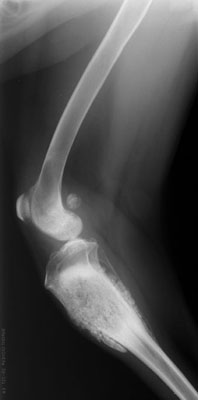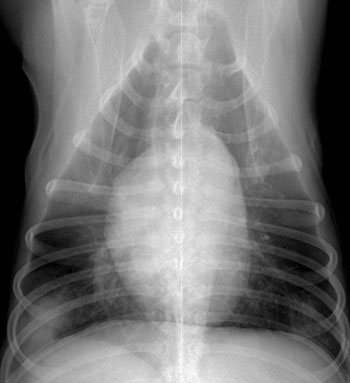The most common early symptoms of primary pulmonary Valley Fever in dogs:
- coughing
- fever
- weight loss
- lack of appetite
- lack of energy
Some or all of these symptoms may be present as a result of infection in the lungs. As the infection progresses, dogs can develop pneumonia that is visible on x-rays.
Valley Fever in dog's lungs
Sometimes the coughing is caused by pressure of swollen lymph nodes near the heart pressing on the dog's windpipe and irritating it.
These dogs often have a dry, hacking or honking kind of cough and the swollen lymph nodes can be seen on x-rays.
When the infection spreads outside the lungs, it causes disseminated disease.
The most common symptom of disseminated disease in dogs is lameness; the fungus has a predilection for infecting bones of the legs in dogs. However, Valley Fever can occur in almost any bone or organ of dogs.
Signs of disseminated Valley Fever can include:
- lameness or swelling of limbs
- back or neck pain, with or without weakness/paralysis
- seizures and other manifestations of brain swelling
- soft abscess-like swelling under the skin
- swollen lymph nodes under the chin, in front of the shoulder blades, or behind the stifles
- non-healing skin wounds that ooze fluid
- eye inflammation with pain or cloudiness
- unexpected heart failure in a young dog
- swollen testicles
Sometimes a dog will not have any signs of a primary infection in the lungs, such as coughing, but will only develop symptoms of disseminated disease, e.g., lameness, seizures. Very few of the signs of Valley Fever are specific to this disease alone and your veterinarian will do tests and x-rays to determine that your dog's illness is Valley Fever and to rule out other causes.
Valley Fever in dog's bone below the knee

What about open sores or draining lesions? Can these make me sick or spread the fungus to the environment?
The form of the organism in the fluid of draining lesions is not considered to be infectious to people or animals.
If your animal is receiving antifungal medication, the number of organisms shed in the fluid is also likely to be very low.
Nevertheless, draining lesions are best handled in a way to minimize the fluid in your environment.
Where possible, wounds can be bandaged. Bandages should be changed daily or every other day and discarded in outside waste containers to minimize risk of having spores grow on the bandage material and become a risk to humans and others in the house.
If the lesion is on the side or back of a dog, a T-shirt can be put on the dog and it should be changed and washed daily or every other day. Cleaning impermeable surfaces with dilute (10%) bleach will kill organisms. Hands should be washed after handling the wounds or bandages.
For immunocompromised persons, pregnant and postpartum women, or babies and very young children living in a household with a pet that has a draining lesion, it is recommended you consult your physician regarding this issue and follow his/her advice.



